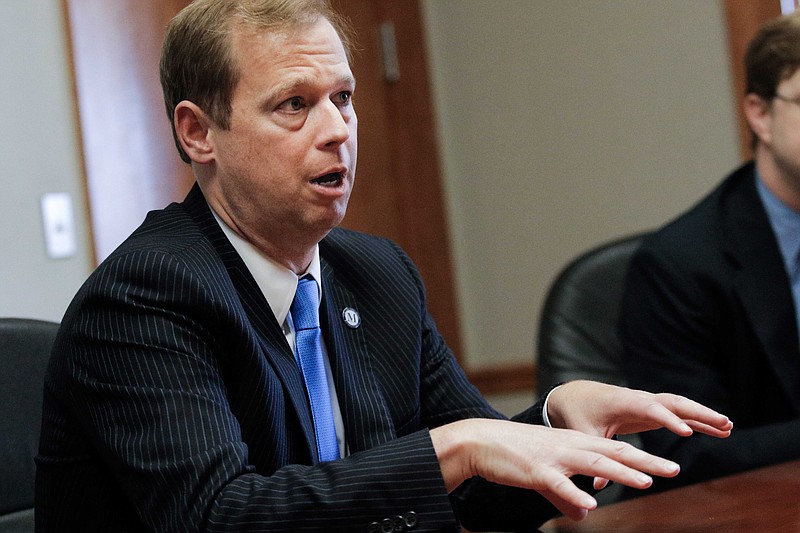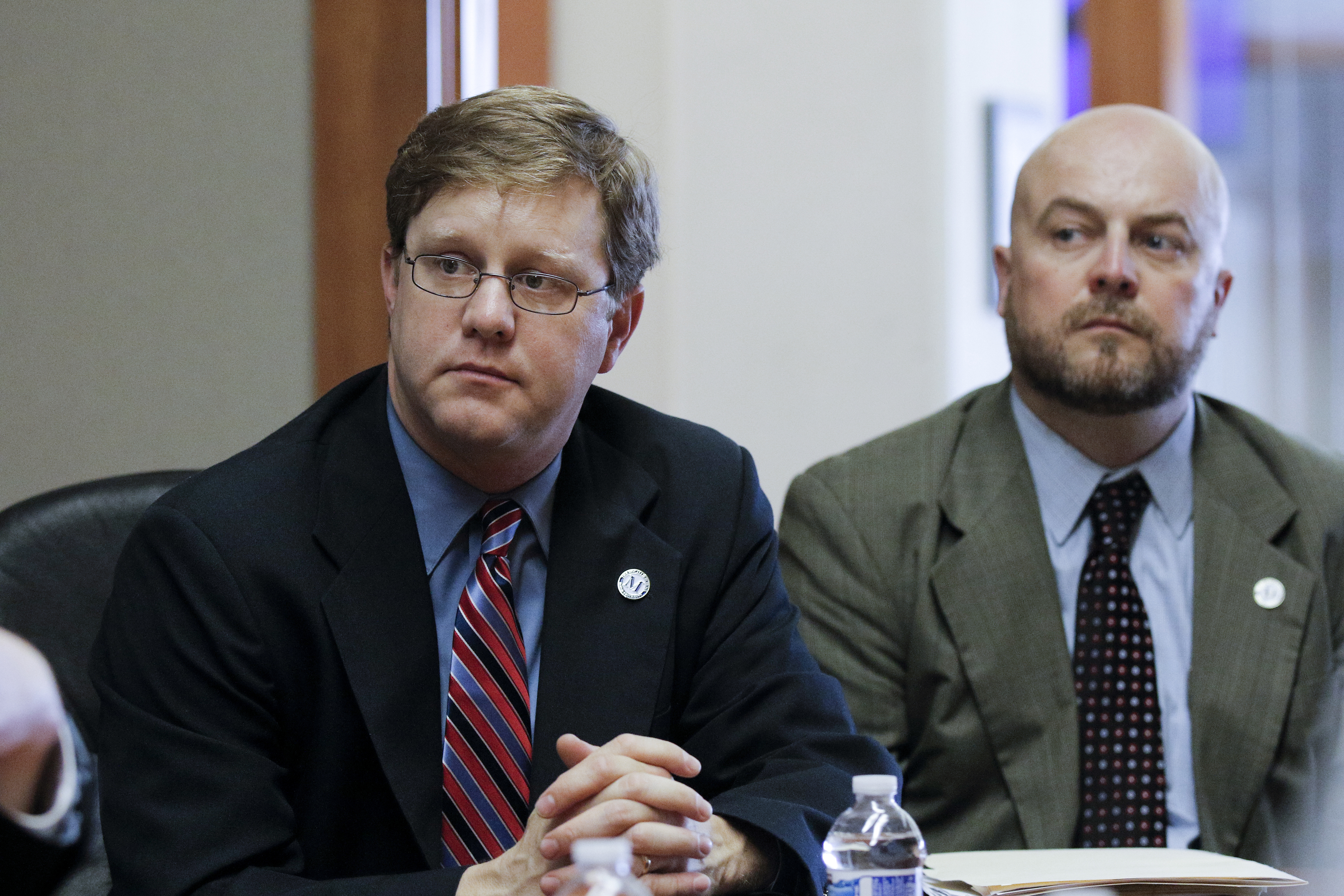By the numbers
* Boys score as well as or better than girls on standardized tests. * Boys receive up to 70 percent of the D's and F's given to all students. * Three out of four learning-disabled students are boys. * Boys create 90 percent of classroom discipline problems. * Eighty percent all high school dropouts are boys. * In the Boston Public Schools graduating class of 2007, there were 191 black girls for every 100 black boys going on to attend a four-year college or university. Among Hispanics, the ratio was 175 girls for every 100 boys; among whites, 153 for every 100. Sources: Christina Hoff Sommers, "The Boys at the Back" an opinion piece in The New York Times. Michael Gurian, "The Minds of Boys: Saving Our Sons from Falling Behind in School and in Life."
Boys aren't doing as well in school -- and often in life -- as girls are, says Lee Burns, the headmaster of McCallie School, a private, 110-year-old, all-boys college prep school in Chattanooga.
Boys have lower grade-point averages than girls, national figures show, and boys are more likely to drop out, to have disciplinary problems and to repeat grades. More women attend college than men do, and women graduate at a higher rate. Women go on to earn more advanced degrees than men.
"Across the board, boys are having a tougher time," Burns said. "That's a great thing that girls are doing well. But in the last couple of decades, it's the boys who have trended down in some pretty significant ways."
That's why McCallie will establish the National Center for the Development of Boys at its campus on the slopes of Missionary Ridge.
The nonprofit center will have its own board of directors and executive director, and will use McCallie as sort of a laboratory to study how to "bring out the best in boys," Burns said. The center will share its research, programs, resources, conferences and ideas with the broader public, according to a McCallie news release, and "will aim to do so for free or very little cost to the public."
"We want this center to be a resource to all different types of schools," Burns said.
It's too early to say what sort of research and ideas may come out of the center, he said. But as the headmaster of an all-boys school who has worked at other boys schools, he has some ideas of what holds boys back and what changes might help them.
"Everything we do at McCallie is designed for a boy," Burns said, who is co-author with Braxton Brady of a Christian-themed book titled "Flight Plan: Your Mission to Become a Man."
Compared to girls, boys are high-energy, he said, and are more geared to visual, spatial and hands-on learning.
"It seems to me that a lot of our classrooms are not well-designed for boys," Burns said. "A lot of time, school is, 'Sit quietly, be still and color inside the lines.' That doesn't resonate well with most boys."
Since research shows that teens do better with more sleep, McCallie recently began starting classes later. Instead of an 8 a.m. start time most days, class starts at 8:30 a.m. now.
"We adjusted the schedule so students can get more sleep," Burns said.
National problem
McCallie officials say their new center, which should be up and running by the next school year, will be the only one they know of dedicated to the educational development of boys.
But the growing education gender gap is getting more national attention by the media and academia, with various explanations and solutions proposed.
Girls are more likely than boys to take school seriously and work hard at it, said Columbia University professor Thomas DiPrete, who co-wrote the 2013 book "The Rise of Women: The Growing Gender Gap in Education and What It Means for American Schools," with Claudia Buchmann.
"They're more engaged in school, they're more organized, they're better-behaved," DiPrete said Wednesday. "It's not that girls are smarter than boys; there's a large group of boys that 'underperform' their test scores."
One thing that holds boys back, he said, is a now-outmoded masculine ideal of a "really strong, independent outdoorsman." That model better served men when jobs were plentiful for farmers, factory workers, truckers and other types of manual and blue-collar laborers.
"It's all about strength, it's not about tests in school," he said.
DiPrete contrasted that old ideal with today's corporate lawyer who did well in school and earns $1 million a year.
"That's really the expression of masculine power now," DiPrete said.
Solutions offered
Male high school students understand they can't walk onto a sports team with no experience and expect to play varsity, DiPrete said. But the equivalent message about building academic skills through years of slow, steady work doesn't get through, he said.
"Doing well in school is a marathon,'" he said. Because of girls' engagement in school, "they've been training for a marathon for years."
The solution is to emphasize academic achievement for boys and girls, DiPrete said.
Britain, Canada and Australia are about a decade ahead of the United States in addressing the needs of boys, said Christina Hoff Sommers, the author of "The War Against Boys: How Misguided Policies Are Harming our Young Men," who's now a resident scholar at the American Enterprise Institute.
Efforts to make school more boy-friendly in those countries include reading assignments geared to boys, such as science fiction, fantasy, sports, espionage, and battles; more recess; more single-sex classes; and more male teachers, Sommers wrote in a 2013 opinion piece for The New York Times, "The Boys in the Back."
"We need a center that studies boys," Sommers said Wednesday when told of McCallie's plans. "It's a challenge to engage a young man in education and hold his interest. If they could develop boy-friendly styles of teaching, it would be so helpful to boys around the country."
"The boys' schools and girls' schools have been under attack by the gender activists," Sommers said. "They want to compare it to segregating people by race, but I think that's absurd. There's great outcomes, these [single-sex] schools produce great outcomes."
Her opinion piece discouraged any gloating over the apparent downfall of men and boys.
"Where was the indignation when men dominated higher education, decade after decade? Isn't it time for women and girls to enjoy the advantages?" Sommers wrote. "The impulse is understandable but misguided. I became a feminist in the 1970s because I did not appreciate male chauvinism. I still don't. But the proper corrective to chauvinism is not to reverse it and practice it against males, but rather basic fairness."
Local efforts
Chattanooga Valley Middle School in Walker County, Ga., experimented for a while with same-sex classrooms, Principal Eugene Ward said.
"It worked great. I loved it," said Ward, who said parents' reaction was "maybe 98 percent positive and 2 percent negative."
Picking books that boys liked to read was one of the things that worked, he said.
The school had to abandon same-sex classes after a couple years, Ward said, because staffing the classes was too difficult. Sometimes only 15 students of one gender would sign up while 30 students of the other gender would, he said.
Ward, who's nearing retirement, says that trying same-sex classrooms stands out as the one of his school's most successful experiments.
"I'm an old man, and I've been through lots of educational [approaches]," Ward said.
Orchard Knob Middle School in Chattanooga, among Hamilton County's five worst-performing schools that are sharing $10 million in federal Innovation Zone funding, is trying same-sex classrooms, but officials there couldn't be reached for comment.
There's such interest in the boys' center idea among people associated with McCallie that it took only a few weeks to raise almost $1 million for the center.
When McCallie held a Sunday afternoon meeting in December about understanding boys, roughly 250 people showed up, Burns said, and many attendees drove an hour or more to get there.
"I think people are hungry for this sort of thing," he said.
Contact staff writer Tim Omarzu at tomarzu@timesfreepress.com or www.facebook.com/tim.omarzu or twitter.com/TimOmarzu or 423-757-6651.

